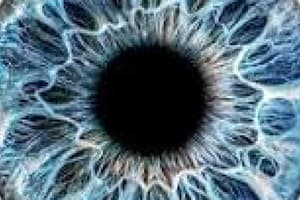Podcast
Questions and Answers
Which region of the crystalline lens contains a higher concentration of refractive proteins?
Which region of the crystalline lens contains a higher concentration of refractive proteins?
- The anterior cortex
- The epithelial cells
- The nucleus
- The posterior cortex (correct)
What is the primary function of the nucleus in the crystalline lens?
What is the primary function of the nucleus in the crystalline lens?
- Preventing age-related changes
- Refracting light
- Accommodating for near and far vision
- Providing structural support and maintaining lens shape (correct)
How does the crystalline lens change shape when focusing on distant objects?
How does the crystalline lens change shape when focusing on distant objects?
- It becomes thicker, increasing its refractive power
- It remains unchanged
- It becomes thinner, increasing its refractive power (correct)
- It becomes thinner, decreasing its refractive power
What is the process called when the crystalline lens changes shape to focus on nearby or distant objects?
What is the process called when the crystalline lens changes shape to focus on nearby or distant objects?
What is the primary cause of presbyopia, an age-related loss of focusing ability?
What is the primary cause of presbyopia, an age-related loss of focusing ability?
What is the primary function of the crystalline lens?
What is the primary function of the crystalline lens?
Which of the following is NOT a distinct region of the crystalline lens?
Which of the following is NOT a distinct region of the crystalline lens?
What is the primary function of the anterior cortex of the crystalline lens?
What is the primary function of the anterior cortex of the crystalline lens?
Which of the following components are found in the anterior cortex of the crystalline lens?
Which of the following components are found in the anterior cortex of the crystalline lens?
What is the approximate diameter of the human crystalline lens?
What is the approximate diameter of the human crystalline lens?
Flashcards
Crystalline Lens
Crystalline Lens
Focuses light onto the retina, located behind the iris and pupil, in front of the vitreous humor.
Anterior Cortex
Anterior Cortex
Outermost layer of the lens, primarily refracts incoming light, composed of water and proteins.
Posterior Cortex
Posterior Cortex
Situated behind the anterior cortex, a higher concentration of refractive proteins such as crystalline lens fibers.
Nucleus (Lens)
Nucleus (Lens)
Signup and view all the flashcards
Accommodation
Accommodation
Signup and view all the flashcards
Presbyopia
Presbyopia
Signup and view all the flashcards
Study Notes
Crystalline Lens Anatomy
The crystalline lens is one of the most important components of the eye that plays a crucial role in vision by focusing light onto the retina. The crystalline lens is located behind the iris and pupil, which control the amount of light entering the eye, and in front of the vitreous humor, a gel-like substance that fills the space between the lens and the retina. In this article, we will explore the anatomy and function of the crystalline lens, its structure, and how it contributes to our eyesight.
Structure
The human lens is shaped like a gradient sphere or ellipsoid, with an average diameter of about 10 mm. Its shape allows it to refract incoming light and adjust its focus based on the distance between the object and the eye. The lens has three distinct regions: anterior cortex, posterior cortex, and nucleus. Each region has different properties and refractive indices, which enable the lens to change shape while focusing light.
Anterior Cortex
The outermost layer of the lens, known as the anterior cortex, is responsible for refracting incoming light. This part of the lens is composed primarily of water and proteins, including collagen fibers, binding proteins, and enzyme inhibitors. The density of these proteins varies across the cortex, creating a radial gradient of light diffraction properties.
Posterior Cortex
The posterior cortex, situated behind the anterior cortex, has a higher concentration of refractive proteins such as crystalline lens fibers. These fibers are predominantly made up of polypeptide chains packed together tightly, forming a highly ordered structure that contributes to the lens's unique refractive properties.
Nucleus
The innermost part of the crystalline lens is the nucleus, which contains fewer refractive proteins but more cellular organelles compared to other regions. It provides structural support for the lens and is responsible for maintaining its shape through processes like epithelial cell division and extracellular matrix deposition.
Function
The function of the crystalline lens can be understood by examining how it changes shape when focusing light on different objects. When viewing distant objects, the lens changes its shape to become thinner, which increases its refractive power and allows the light to converge onto the retina. On the other hand, when looking at nearby objects, the lens thickens, reducing its refractive power and focusing the light closer to the retina. This process is known as accommodation and allows us to see objects clearly regardless of their distance from our eyes.
Age-related Changes
As we age, the crystalline lens undergoes significant changes, leading to presbyopia, an age-related loss of focusing ability. This process involves thickening of the lens due to the accumulation of protein aggregates, reduced elasticity, and stiffening of the extracellular matrix. Over time, these changes lead to decreased accommodative capacity and increased difficulty in focusing on nearby objects.
In conclusion, the human crystalline lens is a marvel of biological engineering that enables us to focus light onto the retina and maintain clear vision throughout our lives. Understanding its anatomy and function can provide valuable insights into diseases and disorders that affect this vital organ, with potential applications in developing new treatments and therapies.
Studying That Suits You
Use AI to generate personalized quizzes and flashcards to suit your learning preferences.





